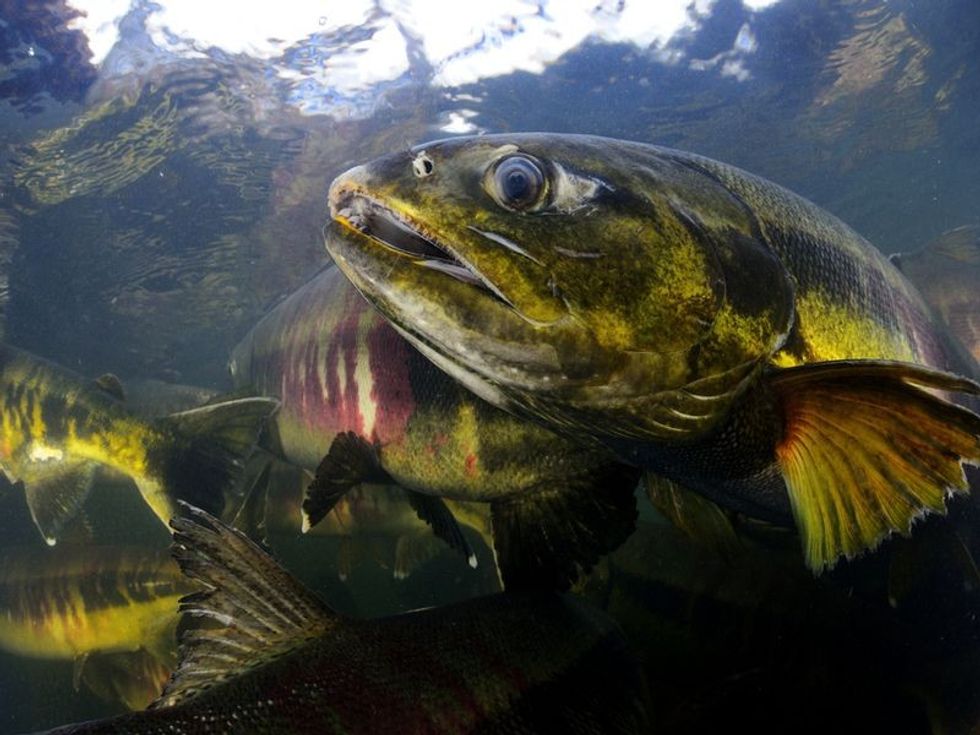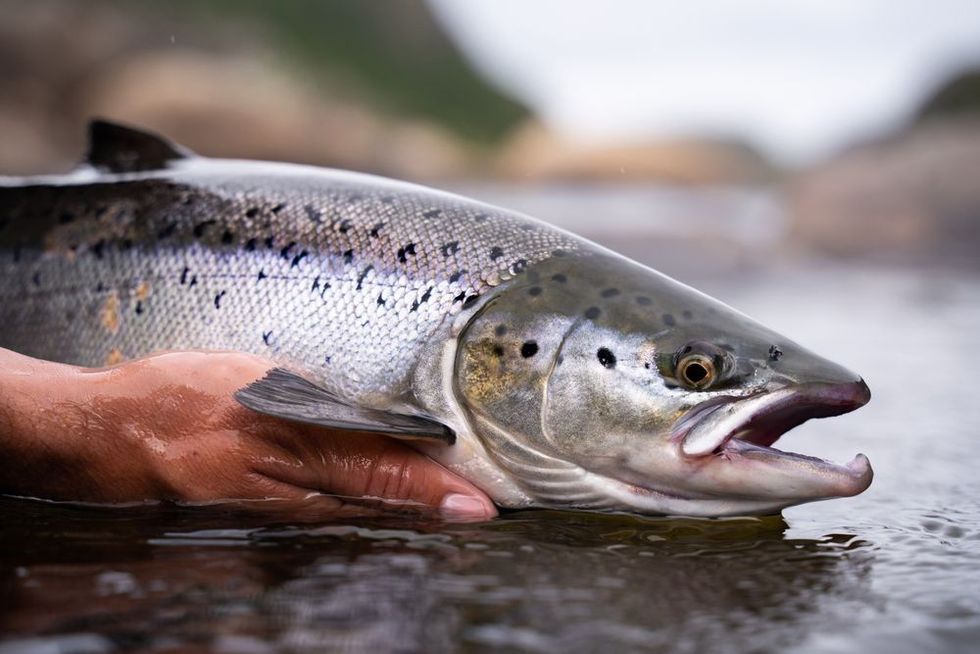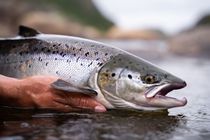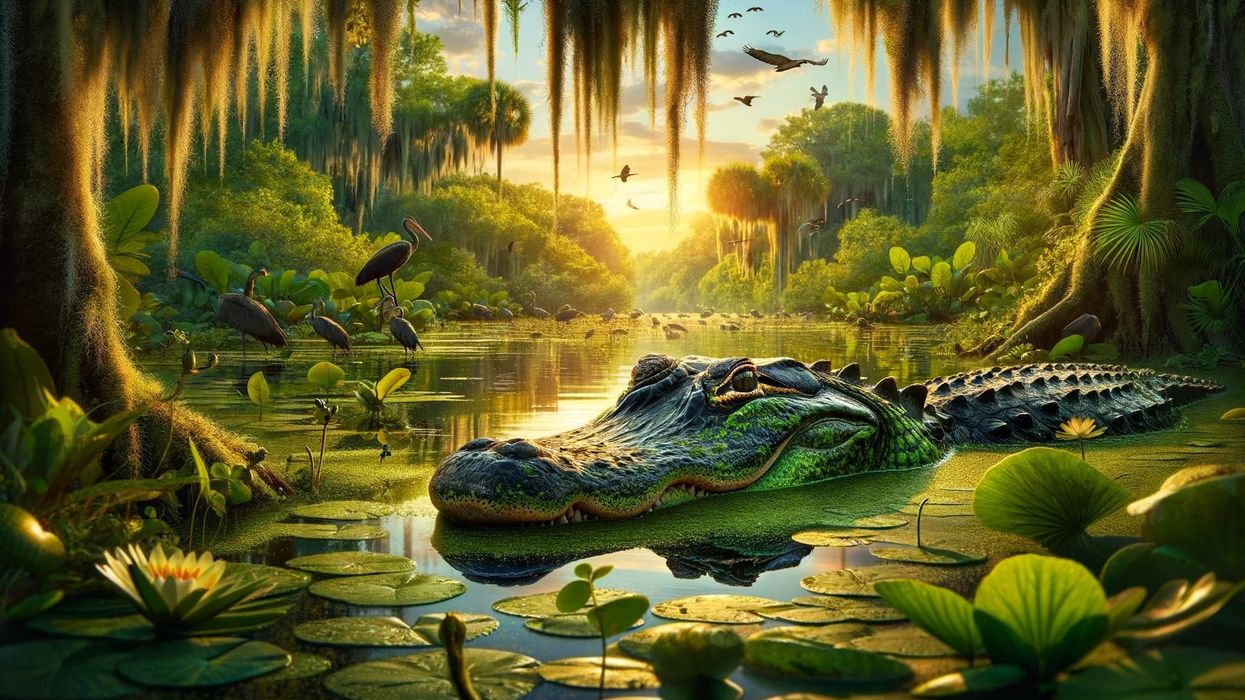What Do Salmon Eat? Complete Feeding Guide And Facts
Salmon farming has a lot of potential in terms of meeting the rising demand for food due to the surge in the worldwide population.
Salmon is a popularly farmed fish in the wild and commercially cultivated, with farmed Atlantic salmon being the most widely available. It is becoming the world's fastest-growing food production industry, compared to wild salmon collected.
Salmon is a good source of protein and nutrients like omega-3 fatty acids and various vitamins and minerals. A 3.5 oz (100 g) serving of farmed salmon includes 41% of the required daily protein consumption and at least 20% of the daily recommended intake of vitamins: B12, B6, B5, B3, D, E, and selenium.
It is also high in potassium, making it an excellent meat substitute for consumption.
The name salmon is derived from the Latin ‘Salmo,’ which in turn emerged from the word ‘salire,’ which means to jump. Salmon are anadromous, they originate in fresh water, migrate to the ocean to grow, and come back to fresh water to spawn.
Salmon species are generally classified into two genera: Salmo and Oncorhynchus. The Atlantic Ocean is home to the Atlantic salmon species of the Salmo genus.
While, the Pacific Ocean has seven different salmon belonging to the Oncorhynchus genus: cherry salmon, Chinook salmon, chum salmon, coho salmon, pink salmon, and sockeye salmon.
Some salmon species are landlocked, spending their whole lives in freshwater and only migrating to big lakes. Such salmon populations can be found across their range, such as steelhead, or rainbow trout, and cutthroat trout; these may be found predominantly in freshwater.
By scaling up aquaculture, we are expected to meet the growing demands in the future for the world's protein needs and reduce pressure on wild fish stocks, allowing them to regenerate. Additionally, new markets and aquatic products are now available for trading on a global scale.
Salmon constitutes quite a significant portion of the diet, notably, in the United States and Europe. Chile, Norway, Scotland, Canada, and the Faroe Islands all rely primarily on salmon aquaculture.
Atlantic salmon is also farmed in Russia, Tasmania, and Australia, however, in minimal quantities. Salmon fish farming began as a trial in 1960, but it became a corporate entity in Norway in the 1980s and Chile in the 1990s.
The salmon farming production cycle lasts around three years. Farmed salmon are raised in controlled water conditions during the first year, until being transferred to seawater habitats. When farmed salmon reach a harvestable size, they are transferred to processing factories, where they are prepared for sale.
Isn't it exciting to discover what salmons eat? Before getting into insights, don't forget to discover more related articles, such as what do frogs eat? And what do iguanas eat?
What do Atlantic salmon eat?
So, what exactly do they eat? Salmon devour a wide variety of foods in the wild, but their natural habitat determines their particular menu.
In general, salmon are carnivores and enjoy a meat-based diet.
When they're young and born in rivers, they eat terrestrial and aquatic insects, amphipods, krill, and other crustaceans; as these fishes grow and migrate to sea as adult salmon, they begin to eat other fish.
Since salmon have a diverse diet in the wild, it might be challenging for salmon farmers to ensure that every single meal meets the maximum potential of growth and sustainability in their feed. Hence, salmon growers are looking for solutions that balance nutrition and environmental challenges to achieve global dietary recommendations.
The Atlantic salmon is the biggest member of the Salmo genus and can thrive in freshwater as well as saltwater. These Atlantic salmon are generally 28-30 in (0.71-0.76 m) long and weigh 8-12 lbs (3.62-5.44 kg), although, they have been caught weighing more than 10 lbs (45.35 kg).
Commercial fishing related to Atlantic salmon is prohibited in the United States; consequently, only farm-raised Atlantic salmon may be obtained in US seafood stores.
In their wild habitat, young Atlantic salmon begin to eat within a few days of hatching. They begin to hunt once the yolk sac has been absorbed into the body, known as alevin.
In freshwater, juveniles prey on small invertebrates like crustaceans, including krill, euphausiids, amphipods, decapods, and aquatic insect larvae like mayflies, black flies, caddisflies, and stoneflies. However, as these Atlantic salmon develop, they start their first migration from their native stream to the ocean.
This migration forms quite an image and is difficult to miss.
Here, the Atlantic salmon diet includes a diverse range of species, including herring, capelin, mackerel, sand lance, barracudina, lanternfish, and smelts. A survey of the content related to Atlantic salmon stomachs reveals that while fish may constitute the majority of the diet in terms of weight, shrimps may constitute 95% of the meal in terms of quantity.
As they return to freshwater to spawn, adults cease feeding completely just before migration to rivers to begin the spawning journey.
What do Chinook salmon eat?
This salmon gets its name from the Chinookan people. It is also known as king salmon because it is the most significant species of Pacific salmon. It also includes several distinct names such as Quinnat salmon, Tsumen, spring salmon, chrome hog, Blackmouth salmon, and Tyee salmon.
This species prefers cold water with temperatures no higher than 710F (250C).
While in the wild habitat, young Chinook salmon diet includes insects, amphipods, and other crustaceans; as they grow into adults, they primarily consume other fishes such as herring. Young salmon eat in rivers and streams only for a short period before migrating into the ocean and procuring more food.
They may grow as long as 4.9 ft (1.49 m) and as heavy as 129 lbs (58.5 kg), although the average adult length and weight are around 3 ft (0.9 m) and 30 lbs (13.6 kg).
Did you know that to attract a spawning partner, salmon can change color? At the same time, the majority of Pacific salmon perish soon after spawning.
The majority of salmon species have a life span of 2-7 years, but an average of 4-5 years of life. Steelhead trout have a life span of around 11 years.
Pacific salmon use all of their energy returning to their home stream, laying eggs, and excavating the nest. When they return to freshwater, most of them stop eating and are unable to return to the ocean after spawning due to a lack of energy.
When they die, they either become food for other animals or decompose, releasing nutrients into the streams. However, unlike Pacific salmon, Atlantic salmon do not die after spawning but survive and reproduce again.
What do salmon eat in the Great Lakes?
Few salmon species like Chinook, coho, pink, sockeye, and two Atlantic salmon species have been introduced into non-native habitats like the Great Lakes of North America. It is said that the word anadromous does not apply to salmon in the Great Lakes, as they enter the water, get landlocked, and spend most of their lives in the Great Lakes.
Specifically, coho and pink salmon never migrated to the sea.
Chinooks were first introduced in the 1870s, but they ended up failing. In 1966, Michigan, New York, Wisconsin, and Ontario joined together to reintroduce them.
The salmon diet in the Great Lakes includes crustaceans, smelt, alewives, forage, and other tiny fish found in freshwater. They stop feeding when their spawning period begins.
Unlike Chinook in the Pacific Ocean, landlocked Chinook prefers water depths of less than 100 ft (30.48 m).
Chinooks in the Great Lakes mature at a slower rate than Chinooks in the ocean, due to differences in feed supplies. Salmon are assumed to have stopped eating in rivers, however, in recent research these fish prey on their eggs and the eggs of other salmon, furthermore, even eggs of other marine animals while spawning in rivers.

What do farmed salmon eat?
Aquaculture provides a source of income and livelihood for millions of people around the world.
Salmon farming of species like Atlantic salmon or Pacific salmon starts with broodstock being picked from seaside production stocks and placed into water tanks about two months before stripping. Before laying eggs in trays or silos, they are scraped dry, fertilized with milt, water hardened, and disinfected.
Some eggs may be shocked as they get changed from one container into another and are then inspected and unfertilized eggs are removed.
Hatching occurs in hatchery trays or after transfer to tanks. Immediately after hatching, the larvae, now known as an alevin, resemble the form of the egg; they are around 70% yolk and 30% embryo.
Alevins are generally kept in gloomy settings and given a matting or rocky substrate to simulate the natural gravel base.
Fry are tiny fish that have just emerged from their gravel nest, commonly known as a redd. The two most significant elements influencing egg and alevin development and survival during the incubation phase, are oxygen and temperature.
From here, eggs and alevins are typically incubated in water at 50°F (10°C). Following yolk sac absorption, alevins will swim up in the water column, indicating that now they are ready to eat for the first time.
First, feeding with inert foods is usually done after transferring fresh alevins into tanks; however, the feed is provided in hatchery trays at first.
Fry catch food in the water, mainly insect nymphs and larvae, and plankton. Feeding to fry can be cultivated in tanks utilizing flow-through, or different recirculation systems, or lake cage systems later on.
Salmon fry can take up to 1-3 years in their home stream or lake to grow, depending on the species.
At this stage, fish is maintained at ambient temperatures and natural light levels to develop as smolts. When these smolts weigh around 1.4- 4.23 oz (40-120g) they are transported to sea sites and modified for saltwater survival.
To adapt salmon to the alterations in their body caused by saline water, they are fed with a plentiful supply of insects and crustaceans, such as herring and small shrimps.
As adults, they are fed with a blend of fish oil, fish meal, and vegetable ingredients. Only around 30 fries from a redd of 2000-2500 eggs survive to become smolts, and only around four survive to become adults.
It is significant to have a nutrient-rich feed for salmon because it plays a significant part in farming profitability and provides the salmon with all the protein and vital elements that provide the nutrient-dense meals that support healthy growth.
Farmed salmon diet is dry pellets made of 70% vegetable constituents and 30% marine raw matters such as fishmeal and fish oil.
Getting into the specifics, the fish feed contains vegetable components originating from plants such as soy, corn, rapeseed, sunflowers, broad beans, and wheat, which serve as proteins, carbohydrates, and fat sources. Other marine ingredients, such as fishmeal and fish oil are made from byproducts of the seafood processing industry that are not suitable for human consumption.
This supplies salmon with necessary additional proteins and minerals. It also aids in providing them with a high dimension of the omega-3 fatty acids EPA and DHA.
In addition, the fish feed contains a balanced quantity of vitamins, minerals, pigments, and amino acids. This is what makes fishmeal so appealing as a protein supplement for being a feed component.
It also includes the antioxidant, astaxanthin, which helps to improve the salmons' immune system and protect their tissue, as well as providing a source of vitamin A. The red color in food is attributable to astaxanthin, which they obtain from eating crustaceans in the wild.
It is important to have high-quality fishmeal that improves overall disease resistance by strengthening and maintaining a healthy, functioning immune system.
Here at Kidadl, we have carefully created lots of interesting family-friendly facts for everyone to enjoy! If you liked our suggestions for what do salmon eat? Then why not take a look at what do koi fish eat or salmon facts?
We Want Your Photos!
More for You
See All
Bachelor of Science specializing in Botany, Master of Science specializing in Clinical Research and Regulatory Affairs

Sridevi ToletyBachelor of Science specializing in Botany, Master of Science specializing in Clinical Research and Regulatory Affairs
With a Master's degree in clinical research from Manipal University and a PG Diploma in journalism from Bharatiya Vidya Bhavan, Sridevi has cultivated her passion for writing across various domains. She has authored a wide range of articles, blogs, travelogues, creative content, and short stories that have been published in leading magazines, newspapers, and websites. Sridevi is fluent in four languages and enjoys spending her spare time with loved ones. Her hobbies include reading, traveling, cooking, painting, and listening to music.
Bachelor of Science specializing in Microbiology, Masters of Science specializing in Biotechnology

Pratiti NathBachelor of Science specializing in Microbiology, Masters of Science specializing in Biotechnology
A Master's in Biotechnology from Presidency University and a Bachelor's in Microbiology from Calcutta University. Pratiti holds expertise in writing science and healthcare articles, and their inputs and feedback help writers create insightful content. They have interests in heritage, history, and climate change issues and have written articles for various websites across multiple subjects. Their experience also includes working with eco-friendly startups and climate-related NGOs.
Disclaimer
1) Kidadl is independent and to make our service free to you the reader we are supported by advertising. We hope you love our recommendations for products and services! What we suggest is selected independently by the Kidadl team. If you purchase using the Buy Now button we may earn a small commission. This does not influence our choices. Prices are correct and items are available at the time the article was published but we cannot guarantee that on the time of reading. Please note that Kidadl is a participant in the Amazon Services LLC Associates Program, an affiliate advertising program designed to provide a means for sites to earn advertising fees by advertising and linking to Amazon. We also link to other websites, but are not responsible for their content.
2) At Kidadl, we strive to recommend the very best activities and events. We will always aim to give you accurate information at the date of publication - however, information does change, so it’s important you do your own research, double-check and make the decision that is right for your family. We recognise that not all activities and ideas are appropriate for all children and families or in all circumstances. Our recommended activities are based on age but these are a guide. We recommend that these ideas are used as inspiration, that ideas are undertaken with appropriate adult supervision, and that each adult uses their own discretion and knowledge of their children to consider the safety and suitability. Kidadl cannot accept liability for the execution of these ideas, and parental supervision is advised at all times, as safety is paramount. Anyone using the information provided by Kidadl does so at their own risk and we can not accept liability if things go wrong.
3) Because we are an educational resource, we have quotes and facts about a range of historical and modern figures. We do not endorse the actions of or rhetoric of all the people included in these collections, but we think they are important for growing minds to learn about under the guidance of parents or guardians.







